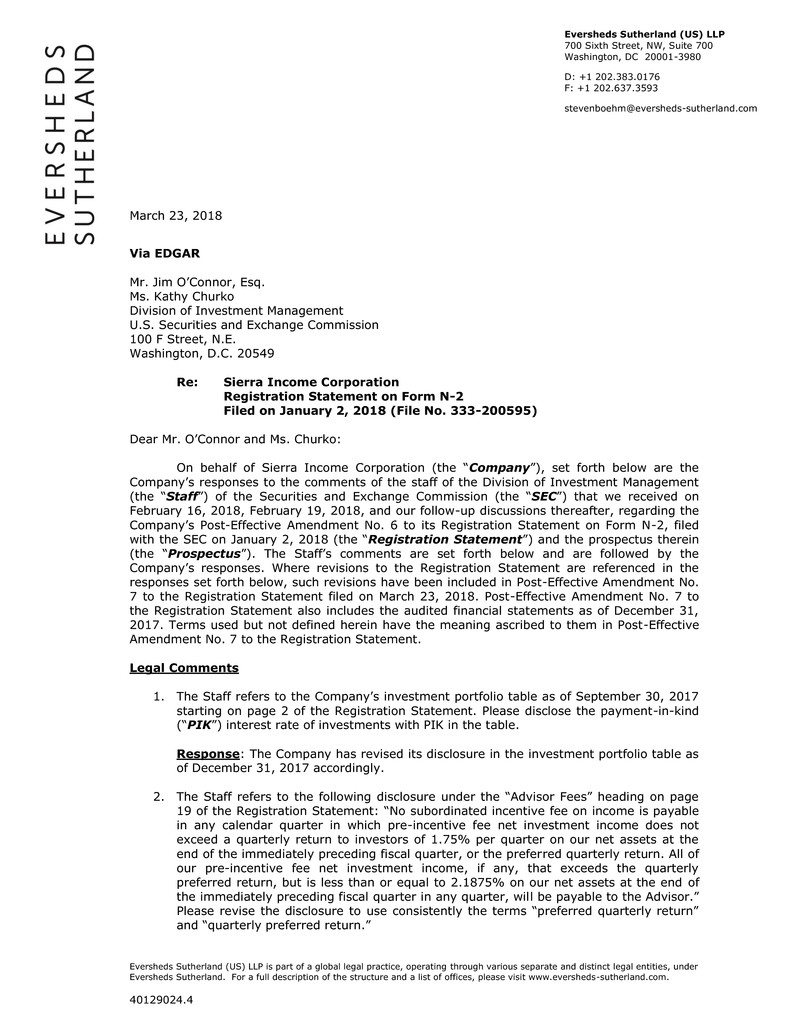
Eversheds Sutherland (US) LLP 700 Sixth Street, NW, Suite 700 Washington, DC 20001-3980 D: +1 202.383.0176 F: +1 202.637.3593 stevenboehm@eversheds-sutherland.com Eversheds Sutherland (US) LLP is part of a global legal practice, operating through various separate and distinct legal entities, under Eversheds Sutherland. For a full description of the structure and a list of offices, please visit www.eversheds-sutherland.com. 40129024.4 March 23, 2018 Via EDGAR Mr. Jim O’Connor, Esq. Ms. Kathy Churko Division of Investment Management U.S. Securities and Exchange Commission 100 F Street, N.E. Washington, D.C. 20549 Re: Sierra Income Corporation Registration Statement on Form N-2 Filed on January 2, 2018 (File No. 333-200595) Dear Mr. O’Connor and Ms. Churko: On behalf of Sierra Income Corporation (the “Company”), set forth below are the Company’s responses to the comments of the staff of the Division of Investment Management (the “Staff”) of the Securities and Exchange Commission (the “SEC”) that we received on February 16, 2018, February 19, 2018, and our follow-up discussions thereafter, regarding the Company’s Post-Effective Amendment No. 6 to its Registration Statement on Form N-2, filed with the SEC on January 2, 2018 (the “Registration Statement”) and the prospectus therein (the “Prospectus”). The Staff’s comments are set forth below and are followed by the Company’s responses. Where revisions to the Registration Statement are referenced in the responses set forth below, such revisions have been included in Post-Effective Amendment No. 7 to the Registration Statement filed on March 23, 2018. Post-Effective Amendment No. 7 to the Registration Statement also includes the audited financial statements as of December 31, 2017. Terms used but not defined herein have the meaning ascribed to them in Post-Effective Amendment No. 7 to the Registration Statement. Legal Comments 1. The Staff refers to the Company’s investment portfolio table as of September 30, 2017 starting on page 2 of the Registration Statement. Please disclose the payment-in-kind (“PIK”) interest rate of investments with PIK in the table. Response: The Company has revised its disclosure in the investment portfolio table as of December 31, 2017 accordingly. 2. The Staff refers to the following disclosure under the “Advisor Fees” heading on page 19 of the Registration Statement: “No subordinated incentive fee on income is payable in any calendar quarter in which pre-incentive fee net investment income does not exceed a quarterly return to investors of 1.75% per quarter on our net assets at the end of the immediately preceding fiscal quarter, or the preferred quarterly return. All of our pre-incentive fee net investment income, if any, that exceeds the quarterly preferred return, but is less than or equal to 2.1875% on our net assets at the end of the immediately preceding fiscal quarter in any quarter, will be payable to the Advisor.” Please revise the disclosure to use consistently the terms “preferred quarterly return” and “quarterly preferred return.”

2 Response: The Company has revised its disclosure accordingly. 3. Under the “Recent Developments” heading on page 21 of the Registration Statement, please identify and set out the distribution yield and dividend yield in the table. Please also set out the amount of each distribution that represents the amount, if any, of return of capital. Response: The Company respectfully advises the Staff on a supplemental basis that the Company has omitted the “Recent Developments” section from Post-Effective Amendment No. 7 to the Registration Statement. 4. The Staff refers to the risk factor on page 46 entitled “To the extent original issue discount constitutes a portion of our income, we will be exposed to risks associated with the deferred receipt of cash representing such income.” Please refer to “original issue discount instruments” as “OID.” Response: The Company has revised its disclosure accordingly. 5. The Staff refers to the risk factor starting on page 50 entitled “We have entered into total return swap agreements or other derivative transactions which expose us to certain risks, including market risk, liquidity risk and other risks similar to those associated with the use of leverage.” The Staff believes that the economic reality underlying the total return swap (“TRS”) is that the BDC purchased the loan portfolio equal to the value of the reference assets with a cash payment and the proceeds of a loan from Citibank. Please confirm that all provisions of the Investment Company Act of 1940, as amended (the “1940 Act”) (specifically including Sections 55, 59, and 61 of the 1940 Act), and the Investment Advisers Act of 1940, as amended (the “Advisers Act” (specifically including Section 205 of the Advisers Act), will be applied on a look- through basis consistent with this economic reality and please explain to the Staff how these provisions will be applied. For example, how is the base fee paid to SIC Advisors LLC (the “Adviser”) calculated; how are the asset coverage rules of Section 61(a) of the 1940 Act applied to the TRS loan portfolio; and how is the determination under Section 55(a) of the 1940 Act made with respect to the TRS loan portfolio? How will the periodic payments received by Arbor under the TRS be treated for the purpose of determining the character of the incentive fees payable to the Adviser under Section 205(b)(3) of the Advisers Act? Assume that Arbor receives payments from Citibank for the total return of the TRS loan portfolio, which, on a look-through basis, is comprised of the interest income and realized gains of the loans. Will the “interest income” represented in the periodic payments be included in the capital gains portion of the incentive fee since periodic payments received from derivative contracts are recorded as realized gains in the financial statements in accordance with GAAP? How will the payments received from Citibank be treated for federal income tax purposes? Typically, interest income is treated as ordinary income and realized gains or losses are treated as capital gains or losses. If Arbor receives one payment for the “total return” of the underlying securities, how will the payment be treated for tax purposes (i.e., will investors have more ordinary income from the securities held through the TRS than from a direct investment in the securities)? Please describe how the valuation of the TRS will affect the accrual and payment of the base management fee. For example, if there is unrealized appreciation from the TRS, would such appreciation increase the amount of the management fee payable to the Adviser? If there is unrealized depreciation from the TRS, would such depreciation reduce the amount of the management fee payable by the Company?
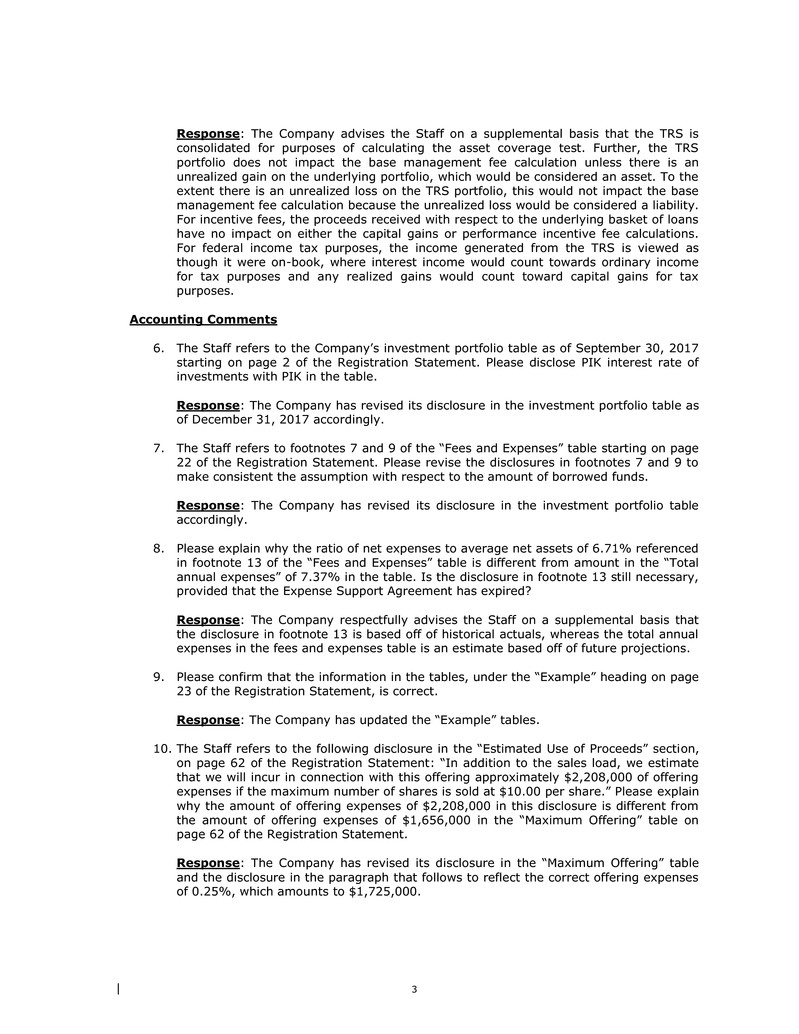
3 Response: The Company advises the Staff on a supplemental basis that the TRS is consolidated for purposes of calculating the asset coverage test. Further, the TRS portfolio does not impact the base management fee calculation unless there is an unrealized gain on the underlying portfolio, which would be considered an asset. To the extent there is an unrealized loss on the TRS portfolio, this would not impact the base management fee calculation because the unrealized loss would be considered a liability. For incentive fees, the proceeds received with respect to the underlying basket of loans have no impact on either the capital gains or performance incentive fee calculations. For federal income tax purposes, the income generated from the TRS is viewed as though it were on-book, where interest income would count towards ordinary income for tax purposes and any realized gains would count toward capital gains for tax purposes. Accounting Comments 6. The Staff refers to the Company’s investment portfolio table as of September 30, 2017 starting on page 2 of the Registration Statement. Please disclose PIK interest rate of investments with PIK in the table. Response: The Company has revised its disclosure in the investment portfolio table as of December 31, 2017 accordingly. 7. The Staff refers to footnotes 7 and 9 of the “Fees and Expenses” table starting on page 22 of the Registration Statement. Please revise the disclosures in footnotes 7 and 9 to make consistent the assumption with respect to the amount of borrowed funds. Response: The Company has revised its disclosure in the investment portfolio table accordingly. 8. Please explain why the ratio of net expenses to average net assets of 6.71% referenced in footnote 13 of the “Fees and Expenses” table is different from amount in the “Total annual expenses” of 7.37% in the table. Is the disclosure in footnote 13 still necessary, provided that the Expense Support Agreement has expired? Response: The Company respectfully advises the Staff on a supplemental basis that the disclosure in footnote 13 is based off of historical actuals, whereas the total annual expenses in the fees and expenses table is an estimate based off of future projections. 9. Please confirm that the information in the tables, under the “Example” heading on page 23 of the Registration Statement, is correct. Response: The Company has updated the “Example” tables. 10. The Staff refers to the following disclosure in the “Estimated Use of Proceeds” section, on page 62 of the Registration Statement: “In addition to the sales load, we estimate that we will incur in connection with this offering approximately $2,208,000 of offering expenses if the maximum number of shares is sold at $10.00 per share.” Please explain why the amount of offering expenses of $2,208,000 in this disclosure is different from the amount of offering expenses of $1,656,000 in the “Maximum Offering” table on page 62 of the Registration Statement. Response: The Company has revised its disclosure in the “Maximum Offering” table and the disclosure in the paragraph that follows to reflect the correct offering expenses of 0.25%, which amounts to $1,725,000.
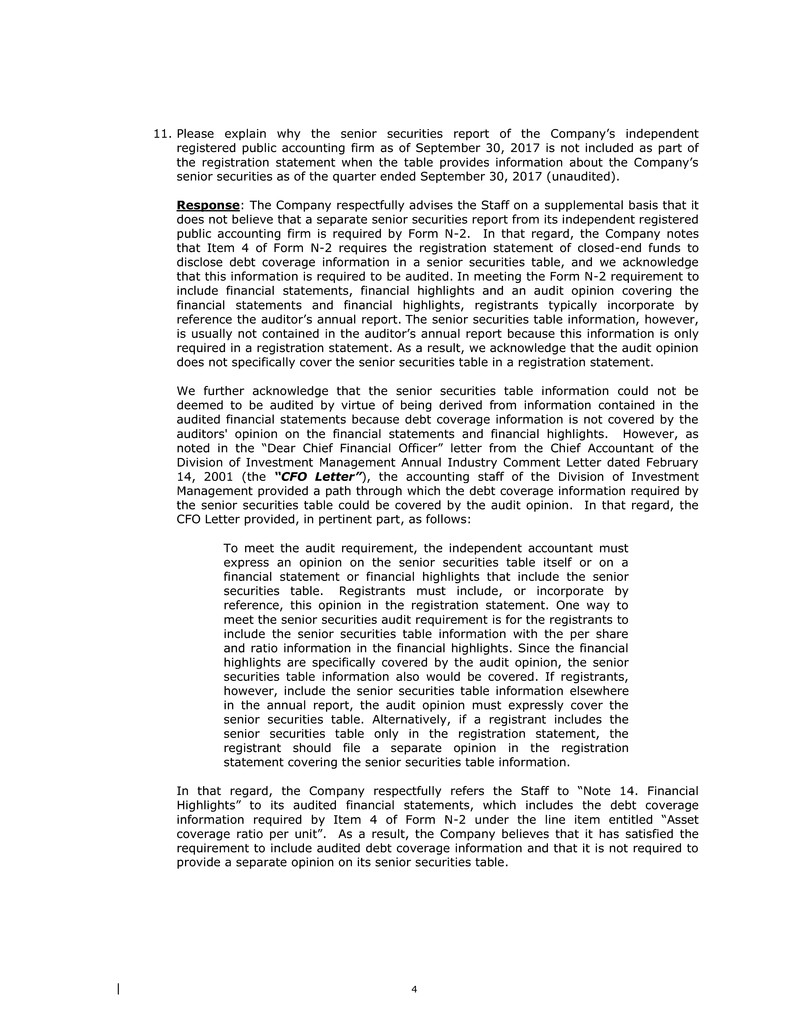
4 11. Please explain why the senior securities report of the Company’s independent registered public accounting firm as of September 30, 2017 is not included as part of the registration statement when the table provides information about the Company’s senior securities as of the quarter ended September 30, 2017 (unaudited). Response: The Company respectfully advises the Staff on a supplemental basis that it does not believe that a separate senior securities report from its independent registered public accounting firm is required by Form N-2. In that regard, the Company notes that Item 4 of Form N-2 requires the registration statement of closed-end funds to disclose debt coverage information in a senior securities table, and we acknowledge that this information is required to be audited. In meeting the Form N-2 requirement to include financial statements, financial highlights and an audit opinion covering the financial statements and financial highlights, registrants typically incorporate by reference the auditor’s annual report. The senior securities table information, however, is usually not contained in the auditor’s annual report because this information is only required in a registration statement. As a result, we acknowledge that the audit opinion does not specifically cover the senior securities table in a registration statement. We further acknowledge that the senior securities table information could not be deemed to be audited by virtue of being derived from information contained in the audited financial statements because debt coverage information is not covered by the auditors' opinion on the financial statements and financial highlights. However, as noted in the “Dear Chief Financial Officer” letter from the Chief Accountant of the Division of Investment Management Annual Industry Comment Letter dated February 14, 2001 (the “CFO Letter”), the accounting staff of the Division of Investment Management provided a path through which the debt coverage information required by the senior securities table could be covered by the audit opinion. In that regard, the CFO Letter provided, in pertinent part, as follows: To meet the audit requirement, the independent accountant must express an opinion on the senior securities table itself or on a financial statement or financial highlights that include the senior securities table. Registrants must include, or incorporate by reference, this opinion in the registration statement. One way to meet the senior securities audit requirement is for the registrants to include the senior securities table information with the per share and ratio information in the financial highlights. Since the financial highlights are specifically covered by the audit opinion, the senior securities table information also would be covered. If registrants, however, include the senior securities table information elsewhere in the annual report, the audit opinion must expressly cover the senior securities table. Alternatively, if a registrant includes the senior securities table only in the registration statement, the registrant should file a separate opinion in the registration statement covering the senior securities table information. In that regard, the Company respectfully refers the Staff to “Note 14. Financial Highlights” to its audited financial statements, which includes the debt coverage information required by Item 4 of Form N-2 under the line item entitled “Asset coverage ratio per unit”. As a result, the Company believes that it has satisfied the requirement to include audited debt coverage information and that it is not required to provide a separate opinion on its senior securities table.
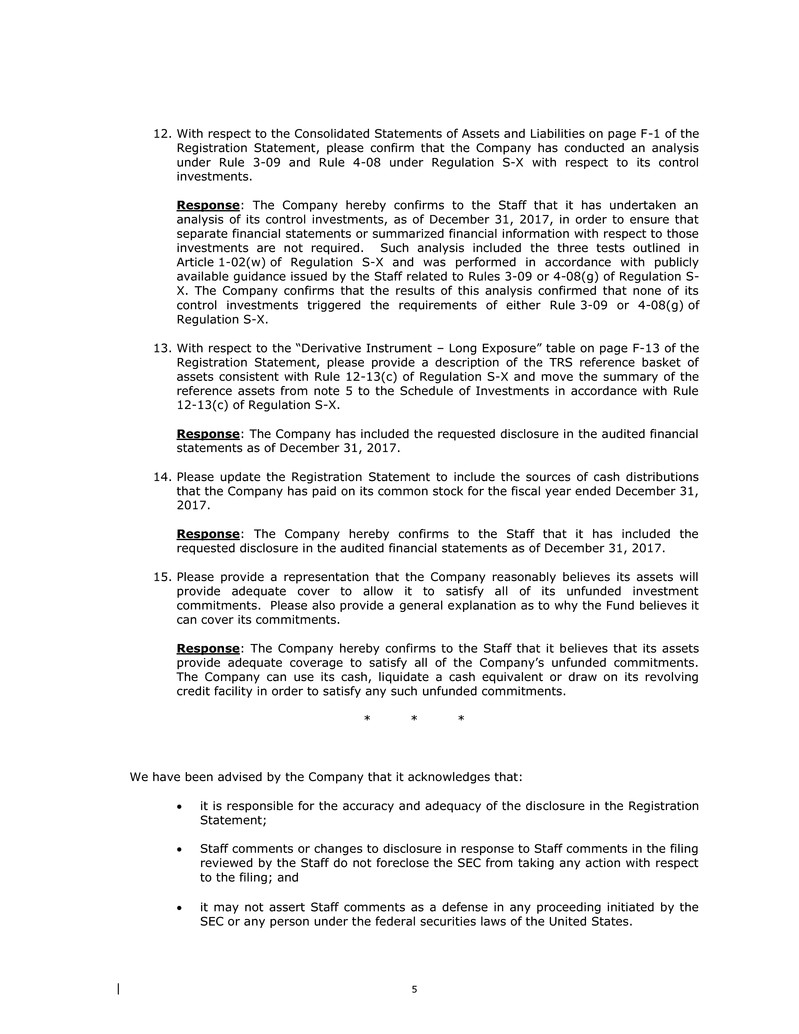
5 12. With respect to the Consolidated Statements of Assets and Liabilities on page F-1 of the Registration Statement, please confirm that the Company has conducted an analysis under Rule 3-09 and Rule 4-08 under Regulation S-X with respect to its control investments. Response: The Company hereby confirms to the Staff that it has undertaken an analysis of its control investments, as of December 31, 2017, in order to ensure that separate financial statements or summarized financial information with respect to those investments are not required. Such analysis included the three tests outlined in Article 1-02(w) of Regulation S-X and was performed in accordance with publicly available guidance issued by the Staff related to Rules 3-09 or 4-08(g) of Regulation S- X. The Company confirms that the results of this analysis confirmed that none of its control investments triggered the requirements of either Rule 3-09 or 4-08(g) of Regulation S-X. 13. With respect to the “Derivative Instrument – Long Exposure” table on page F-13 of the Registration Statement, please provide a description of the TRS reference basket of assets consistent with Rule 12-13(c) of Regulation S-X and move the summary of the reference assets from note 5 to the Schedule of Investments in accordance with Rule 12-13(c) of Regulation S-X. Response: The Company has included the requested disclosure in the audited financial statements as of December 31, 2017. 14. Please update the Registration Statement to include the sources of cash distributions that the Company has paid on its common stock for the fiscal year ended December 31, 2017. Response: The Company hereby confirms to the Staff that it has included the requested disclosure in the audited financial statements as of December 31, 2017. 15. Please provide a representation that the Company reasonably believes its assets will provide adequate cover to allow it to satisfy all of its unfunded investment commitments. Please also provide a general explanation as to why the Fund believes it can cover its commitments. Response: The Company hereby confirms to the Staff that it believes that its assets provide adequate coverage to satisfy all of the Company’s unfunded commitments. The Company can use its cash, liquidate a cash equivalent or draw on its revolving credit facility in order to satisfy any such unfunded commitments. * * * We have been advised by the Company that it acknowledges that: it is responsible for the accuracy and adequacy of the disclosure in the Registration Statement; Staff comments or changes to disclosure in response to Staff comments in the filing reviewed by the Staff do not foreclose the SEC from taking any action with respect to the filing; and it may not assert Staff comments as a defense in any proceeding initiated by the SEC or any person under the federal securities laws of the United States.
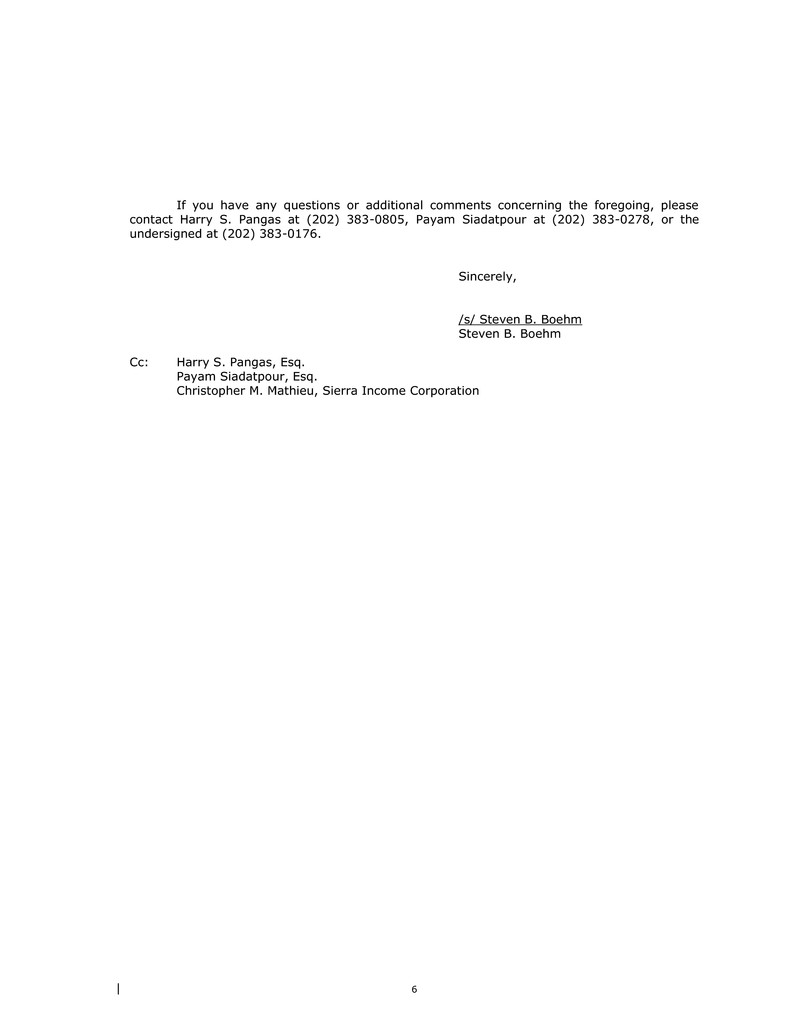
6 If you have any questions or additional comments concerning the foregoing, please contact Harry S. Pangas at (202) 383-0805, Payam Siadatpour at (202) 383-0278, or the undersigned at (202) 383-0176. Sincerely, /s/ Steven B. Boehm Steven B. Boehm Cc: Harry S. Pangas, Esq. Payam Siadatpour, Esq. Christopher M. Mathieu, Sierra Income Corporation





